Identifying Key Factors Associated with Green Justice in Accessibility: A Gradient Boosting Decision Tree Analysis
Abstract
:1. Introduction
2. Materials and Methods
2.1. Study Area and Data
2.2. Variables
2.3. Methods
2.3.1. The Gaussian-Based 2SFCA Method for Accessibility
2.3.2. The Gini Coefficient for Spatial Equity
2.3.3. The Gradient Boosting Decision Tree (GBDT) Model
3. Results
3.1. Spatial Equality in Accessibility by Two Traffic Modes
3.1.1. Spatial Accessibility for Two Traffic Modes
3.1.2. Spatial Equality in Accessibility
3.2. Nonlinear Influence on Accessibility and Equity
3.2.1. Analysis of the Relative Importance of Influencing Factors
3.2.2. Threshold Effect of Key Variables in Accessibility
3.2.3. Threshold Effects of Key Variables in Equity
4. Discussion
4.1. Advantages of the GBDT Method for Green Justice
4.2. Implications for Urban Planning Based on the Effects of Heterogeneity and Synergy
4.3. Limitations
5. Conclusions
Author Contributions
Funding
Institutional Review Board Statement
Informed Consent Statement
Data Availability Statement
Acknowledgments
Conflicts of Interest
References
- Lee, A.C.K.; Maheswaran, R. The health benefits of urban green spaces: A review of the evidence. J. Public Health 2011, 33, 212–222. [Google Scholar] [CrossRef] [PubMed]
- Chiesura, A. The role of urban parks for the sustainable city. Landsc. Urban Plan. 2004, 68, 129–138. [Google Scholar] [CrossRef]
- Kabisch, N.; Haase, D. Green justice or just green? Provision of urban green spaces in Berlin, Germany. Landsc. Urban Plan. 2014, 122, 129–139. [Google Scholar] [CrossRef]
- Markevych, I.; Schoierer, J.; Hartig, T.; Chudnovsky, A.; Hystad, P.; Dzhambov, A.M.; de Vries, S.; Triguero-Mas, M.; Brauer, M.; Nieuwenhuijsen, M.J.; et al. Exploring pathways linking greenspace to health: Theoretical and methodological guidance. Environ. Res. 2017, 158, 301–317. [Google Scholar] [CrossRef]
- Dony, C.C.; Delmelle, E.M.; Delmelle, E.C. Re-conceptualizing accessibility to parks in multi-modal cities: A Variable-width Floating Catchment Area (VFCA) method. Landsc. Urban Plan. 2015, 143, 90–99. [Google Scholar] [CrossRef]
- Wustemann, H.; Kalisch, D.; Kolbe, J. Access to urban green space and environmental inequalities in Germany. Landsc. Urban Plan. 2017, 164, 124–131. [Google Scholar] [CrossRef]
- Crane, P.; Kinzig, A. Nature in the metropolis. Science 2005, 308, 1225. [Google Scholar] [CrossRef]
- Wolch, J.R.; Byrne, J.; Newell, J.P. Urban green space, public health, and environmental justice: The challenge of making cities ‘just green enough’. Landsc. Urban Plan. 2014, 125, 234–244. [Google Scholar] [CrossRef]
- Jennings, W.G.; Reingle, J.M. On the number and shape of developmental/life-course violence, aggression, and delinquency trajectories: A state-of-the-art review. J. Crim. Justice 2012, 40, 472–489. [Google Scholar] [CrossRef]
- Bruton, C.M.; Floyd, M.F. Disparities in built and natural features of urban parks: Comparisons by neighborhood level race/ethnicity and income. J. Urban Health Bull. N. Y. Acad. Med. 2014, 91, 894–907. [Google Scholar] [CrossRef]
- Rigolon, A. A complex landscape of inequity in access to urban parks: A literature review. Landsc. Urban Plan. 2016, 153, 160–169. [Google Scholar] [CrossRef]
- Lee, G.; Hong, I. Measuring spatial accessibility in the context of spatial disparity between demand and supply of urban park service. Landsc. Urban Plan. 2013, 119, 85–90. [Google Scholar] [CrossRef]
- Dai, D. Racial/ethnic and socioeconomic disparities in urban green space accessibility: Where to intervene? Landsc. Urban Plan. 2011, 102, 234–244. [Google Scholar] [CrossRef]
- Byrne, J.; Wolch, J. Nature, race, and parks: Past research and future directions for geographic research. Prog. Hum. Geogr. 2009, 33, 743–765. [Google Scholar] [CrossRef]
- Yao, L.; Liu, J.R.; Wang, R.S.; Yin, K.; Han, B.L. Effective green equivalent-A measure of public green spaces for cities. Ecol. Indic. 2014, 47, 123–127. [Google Scholar] [CrossRef]
- Xing, L.J.; Liu, Y.F.; Wang, B.S.; Wang, Y.H.; Liu, H.J. An environmental justice study on spatial access to parks for youth by using an improved 2SFCA method in Wuhan, China. Cities 2020, 96, 102405. [Google Scholar] [CrossRef]
- Jackson, L.E. The relationship of urban design to human health and condition. Landsc. Urban Plan. 2003, 64, 191–200. [Google Scholar] [CrossRef]
- Nicholls, S. Measuring the accessibility and equity of public parks: A case study using GIS. Manag. Leis. 2001, 6, 201–219. [Google Scholar] [CrossRef]
- Moore, L.V.; Diez Roux, A.V.; Evenson, K.R.; McGinn, A.P.; Brines, S.J. Availability of recreational resources in minority and low socioeconomic status areas. Am. J. Prev. Med. 2008, 34, 16–22. [Google Scholar] [CrossRef]
- Miyake, K.K.; Maroko, A.R.; Grady, K.L.; Maantay, J.A.; Arno, P.S. Not just a walk in the park: Methodological improvements for determining environmental justice implications of park access in New York City for the promotion of physical activity. Cities Environ. 2010, 3, 1–17. [Google Scholar] [CrossRef]
- Sister, C.; Wolch, J.; Wilson, J. Got green? addressing environmental justice in park provision. Geojournal 2010, 75, 229–248. [Google Scholar] [CrossRef]
- McCormack, G.R.; Rock, M.; Toohey, A.M.; Hignell, D. Characteristics of urban parks associated with park use and physical activity: A review of qualitative research. Health Place 2010, 16, 712–726. [Google Scholar] [CrossRef]
- Tao, Z.L.; Cheng, Y.; Liu, J.X. Hierarchical two-step floating catchment area (2SFCA) method: Measuring the spatial accessibility to hierarchical healthcare facilities in Shenzhen, China. Int. J. Equity Health 2020, 19, 1–16. [Google Scholar] [CrossRef] [PubMed]
- Rigolon, A. Parks and young people: An environmental justice study of park proximity, acreage, and quality in Denver, Colorado. Landsc. Urban Plan. 2017, 165, 73–83. [Google Scholar] [CrossRef]
- Nesbitt, L.; Meitner, M.J.; Girling, C.; Sheppard, S.R.J.; Lu, Y. Who has access to urban vegetation? A spatial analysis of distributional green equity in 10 US cities. Landsc. Urban Plan. 2019, 181, 51–79. [Google Scholar] [CrossRef]
- Wu, L.F.; Kim, S.K. Exploring the equality of accessing urban green spaces: A comparative study of 341 Chinese cities. Ecol. Indic. 2021, 121, 107080. [Google Scholar] [CrossRef]
- Zhang, R.; Zhang, C.-Q.; Cheng, W.; Lai, P.C.; Schüz, B. The neighborhood socioeconomic inequalities in urban parks in a High-density City: An environmental justice perspective. Landsc. Urban Plan. 2021, 211, 104099. [Google Scholar] [CrossRef]
- Schuele, S.A.; Gabriel, K.M.A.; Bolte, G. Relationship between neighbourhood socioeconomic position and neighbourhood public green space availability: An environmental inequality analysis in a large German city applying generalized linear models. Int. J. Hyg. Environ. Health 2017, 220, 711. [Google Scholar] [CrossRef]
- Wang, S.; Wang, M.; Liu, Y. Access to urban parks: Comparing spatial accessibility measures using three GIS-based approaches. Comput. Environ. Urban Syst. 2021, 90, 101713. [Google Scholar] [CrossRef]
- Zhang, J.; Yu, Z.; Cheng, Y.; Chen, C.; Wan, Y.; Zhao, B.; Vejre, H. Evaluating the disparities in urban green space provision in communities with diverse built environments: The case of a rapidly urbanizing Chinese city. Build. Environ. 2020, 183, 107170. [Google Scholar] [CrossRef]
- Ayala-Azcarraga, C.; Diaz, D.; Zambrano, L. Characteristics of urban parks and their relation to user well-being. Landsc. Urban Plan. 2019, 189, 27–35. [Google Scholar] [CrossRef]
- Li, H.; Liu, Y. Neighborhood socioeconomic disadvantage and urban public green spaces availability: A localized modeling approach to inform land use policy. Land Use Policy 2016, 57, 470–478. [Google Scholar] [CrossRef]
- Xu, C.; Haase, D.; Pribadi, D.O.; Pauleit, S. Spatial variation of green space equity and its relation with urban dynamics: A case study in the region of Munich. Ecol. Indic. 2018, 93, 512–523. [Google Scholar] [CrossRef]
- Wei, F. Greener urbanization? Changing accessibility to parks in China. Landsc. Urban Plan. 2017, 157, 542–552. [Google Scholar] [CrossRef]
- Handy, S. Is accessibility an idea whose time has finally come? Transp. Res. Part D Transp. Environ. 2020, 83, 102319. [Google Scholar] [CrossRef]
- Yue, W.Z.; Fan, P.L.; Wei, Y.D.; Qi, J.G. Economic development, urban expansion, and sustainable development in Shanghai. Stoch. Environ. Res. Risk Assess. 2014, 28, 783–799. [Google Scholar] [CrossRef]
- Xiao, Y.; Wang, D.; Fang, J. Exploring the disparities in park access through mobile phone data: Evidence from Shanghai, China. Landsc. Urban Plan. 2019, 181, 80–91. [Google Scholar] [CrossRef]
- Kong, F.; Yin, H.; Nakagoshi, N. Using GIS and landscape metrics in the hedonic price modeling of the amenity value of urban green space: A case study in Jinan City, China. Landsc. Urban Plan. 2007, 79, 240–252. [Google Scholar] [CrossRef]
- Yan, J.; Zhang, G.; Ling, H.; Han, F. Comparison of time-integrated NDVI and annual maximum NDVI for assessing grassland dynamics. Ecol. Indic. 2022, 136, 108611. [Google Scholar] [CrossRef]
- Zhang, W.; Lu, D.; Zhao, Y.; Luo, X.; Yin, J. Incorporating polycentric development and neighborhood life-circle planning for reducing driving in Beijing: Nonlinear and threshold analysis. Cities 2022, 121, 103488. [Google Scholar] [CrossRef]
- Zhu, W.J.; Ding, C.; Cao, X.Y. Built environment effects on fuel consumption of driving to work: Insights from on-board diagnostics data of personal vehicles. Transp. Res. Part D Transp. Environ. 2019, 67, 565–575. [Google Scholar] [CrossRef]
- Wu, X.Y.; Tao, T.; Cao, J.S.; Fan, Y.L.; Ramaswami, A. Examining threshold effects of built environment elements on travel-related carbon-dioxide emissions. Transp. Res. Part D Transp. Environ. 2019, 75, 1–12. [Google Scholar] [CrossRef]
- Cao, X.S.; Yang, W.Y. Examining the effects of the built environment and residential self-selection on commuting trips and the related CO2 emissions: An empirical study in Guangzhou, China. Transp. Res. Part D Transp. Environ. 2017, 52, 480–494. [Google Scholar] [CrossRef]
- Li, Z.; Fan, Z.; Song, Y.; Chai, Y. Assessing equity in park accessibility using a travel behavior-based G2SFCA method in Nanjing, China. J. Transp. Geogr. 2021, 96, 103179. [Google Scholar] [CrossRef]
- Khan, M.K.; Teng, J.-Z.; Khan, M.I.; Khan, M.O. Impact of globalization, economic factors and energy consumption on CO2 emissions in Pakistan. Sci. Total Environ. 2019, 688, 424–436. [Google Scholar] [CrossRef] [PubMed]
- Jiang, L.; He, S.X.; Cui, Y.Z.; Zhou, H.F.; Kong, H. Effects of the socio-economic influencing factors on SO2 pollution in Chinese cities: A spatial econometric analysis based on satellite observed data. J. Environ. Manag. 2020, 268, 110667. [Google Scholar] [CrossRef]
- Xing, L.J.; Liu, Y.F.; Liu, X.J.; Wei, X.J.; Mao, Y. Spatio-temporal disparity between demand and supply of park green space service in urban area of Wuhan from 2000 to 2014. Habitat Int. 2018, 71, 49–59. [Google Scholar] [CrossRef]
- Wu, C.; Ye, X.Y.; Du, Q.Y.; Luo, P. Spatial effects of accessibility to parks on housing prices in Shenzhen, China. Habitat Int. 2017, 63, 45–54. [Google Scholar] [CrossRef]
- Radke, J.; Mu, L. Spatial decompositions, modeling and mapping service regions to predict access to social programs. Geogr. Inf. Sci. 2000, 6, 105–112. [Google Scholar] [CrossRef]
- Luo, W.; Wang, F.H. Measures of spatial accessibility to health care in a GIS environment: Synthesis and a case study in the Chicago region. Environ. Plan. B Plan. Des. 2003, 30, 865–884. [Google Scholar] [CrossRef]
- Luo, W.; Qi, Y. An enhanced two-step floating catchment area (E2SFCA) method for measuring spatial accessibility to primary care physicians. Health Place 2009, 15, 1100–1107. [Google Scholar] [CrossRef] [PubMed]
- Jamtsho, S.; Corner, R.; Dewan, A. Spatio-temporal analysis of spatial accessibility to primary health care in Bhutan. ISPRS Int. J. Geo-Inf. 2015, 4, 1584–1604. [Google Scholar] [CrossRef]
- Delamater, P.L. Spatial accessibility in suboptimally configured health care systems: A modified two-step floating catchment area (M2SFCA) metric. Health Place 2013, 24, 30–43. [Google Scholar] [CrossRef]
- Liang, H.L.; Zhang, Q.P. Assessing the public transport service to urban parks on the basis of spatial accessibility for citizens in the compact megacity of Shanghai, China. Urban Stud. 2018, 55, 1983–1999. [Google Scholar] [CrossRef]
- Langford, M.; Higgs, G.; Fry, R. Multi-modal two-step floating catchment area analysis of primary health care accessibility. Health Place 2016, 38, 70–81. [Google Scholar] [CrossRef] [PubMed]
- Wu, H.Y.; Wang, L.X.; Zhang, Z.H.; Gao, J. Analysis and optimization of 15-minute community life circle based on supply and demand matching: A case study of Shanghai. PLoS ONE 2021, 16, e0256904. [Google Scholar] [CrossRef]
- Lorenz, M.O. Methods of measuring the concentration of wealth. Publ. Am. Stat. Assoc. 1905, 9, 209–219. [Google Scholar] [CrossRef]
- Yaping, M.; Shifeng, F. Research of reference evapotranspiration‘s simulation based on machine learning. J. Geo-Inf. Sci. 2020, 22, 1692–1701. [Google Scholar]
- Friedman, J.H. Greedy function approximation: A gradient boosting machine. Ann. Stat. 2001, 29, 1189–1232. [Google Scholar] [CrossRef]
- Chen, E.H.; Ye, Z.R.; Wu, H. Nonlinear effects of built environment on intermodal transit trips considering spatial heterogeneity. Transp. Res. Part D-Transp. Environ. 2021, 90, 102677. [Google Scholar] [CrossRef]
- Tao, T.; Wang, J.; Cao, X. Exploring the non-linear associations between spatial attributes and walking distance to transit. J. Transp. Geogr. 2020, 82, 102560. [Google Scholar] [CrossRef]
- Zuniga-Teran, A.A.; Stoker, P.; Gimblett, R.H.; Orr, B.J.; Marsh, S.E.; Guertin, D.P.; Chalfoun, N.V. Exploring the influence of neighborhood walkability on the frequency of use of greenspace. Landsc. Urban Plan. 2019, 190, 103609. [Google Scholar] [CrossRef]
- Elith, J.; Leathwick, J.R.; Hastie, T. A working guide to boosted regression trees. J. Anim. Ecol. 2008, 77, 802–813. [Google Scholar] [CrossRef] [PubMed]
- Sallis, J.F.; Floyd, M.F.; Rodriguez, D.A.; Saelens, B.E. Role of built environments in physical activity, obesity, and cardiovascular disease. Circulation 2012, 125, 729–737. [Google Scholar] [CrossRef]
- Evenson, K.R.; Wen, F.; Hillier, A.; Cohen, D.A. Assessing the contribution of parks to physical activity using global positioning system and accelerometry. Med. Sci. Sports Exerc. 2013, 45, 1981–1987. [Google Scholar] [CrossRef]
- Chen, Y.; Yue, W.; La Rosa, D. Which communities have better accessibility to green space? An investigation into environmental inequality using big data. Landsc. Urban Plan. 2020, 204, 103919. [Google Scholar] [CrossRef]
- Liu, Y.; Wang, R.; Xiao, Y.; Huang, B.; Chen, H.; Li, Z. Exploring the linkage between greenness exposure and depression among chinese people: Mediating roles of physical activity, stress and social cohesion and moderating role of urbanicity-sciencedirect. Health Place 2019, 58, 102168. [Google Scholar] [CrossRef]
- Liu, B.; Tian, Y.; Guo, M.; Tran, D.; Alwah, A.A.Q.; Xu, D. Evaluating the disparity between supply and demand of park green space using a multi-dimensional spatial equity evaluation framework. Cities. 2022, 121, 103484. [Google Scholar] [CrossRef]
- Hu, S.J.; Song, W.; Li, C.G.; Lu, J. A multi-mode Gaussian-based two-step floating catchment area method for measuring accessibility of urban parks. Cities 2020, 105, 102815. [Google Scholar] [CrossRef]
- Yen, Y.; Wang, Z.; Shi, Y.; Xu, F.; Soeung, B.; Sohail, M.T.; Rubakula, G.; Juma, S.A. The predictors of the behavioral intention to the use of urban green spaces: The perspectives of young residents in Phnom Penh, Cambodia. Habitat Int. 2017, 64, 98–108. [Google Scholar] [CrossRef]

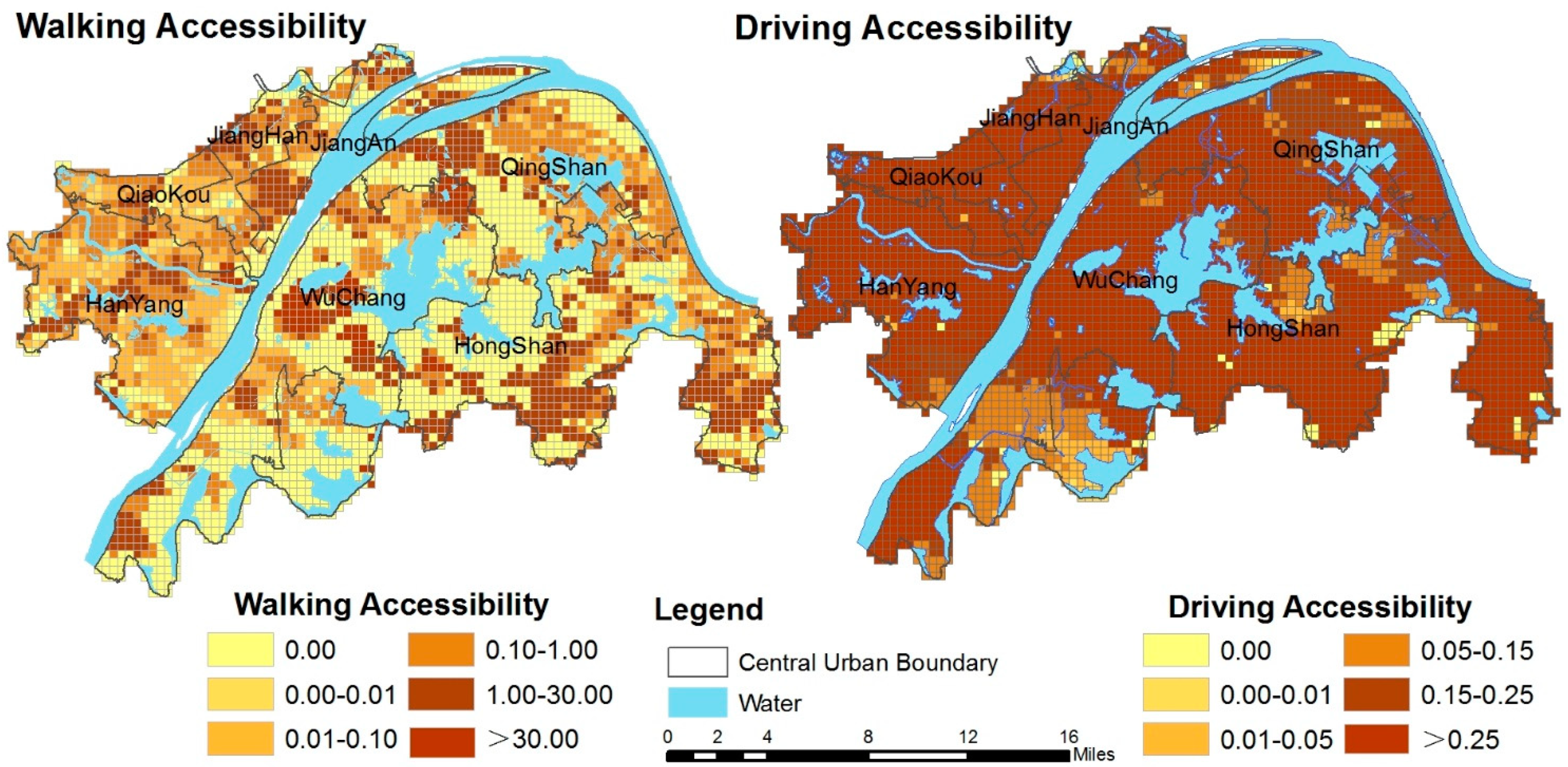


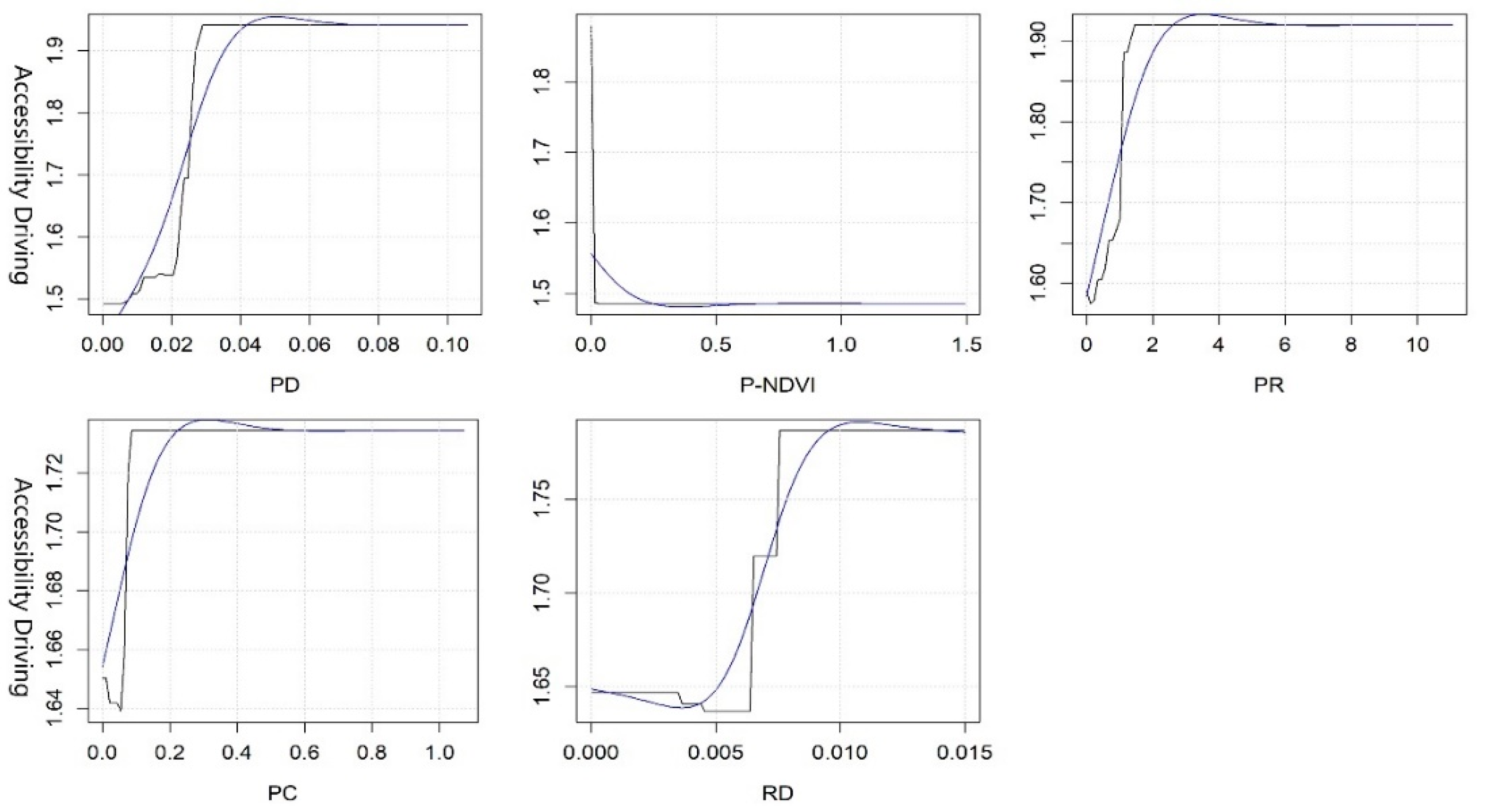
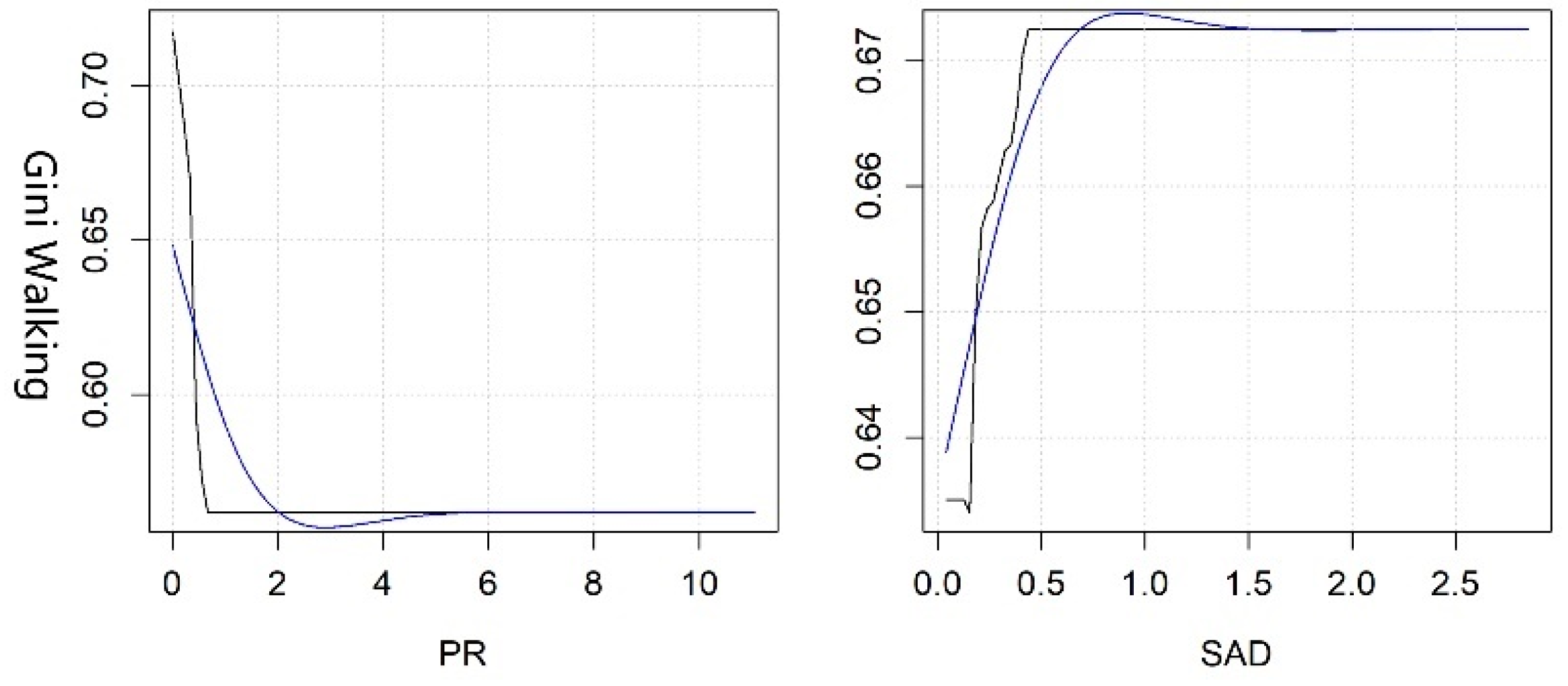
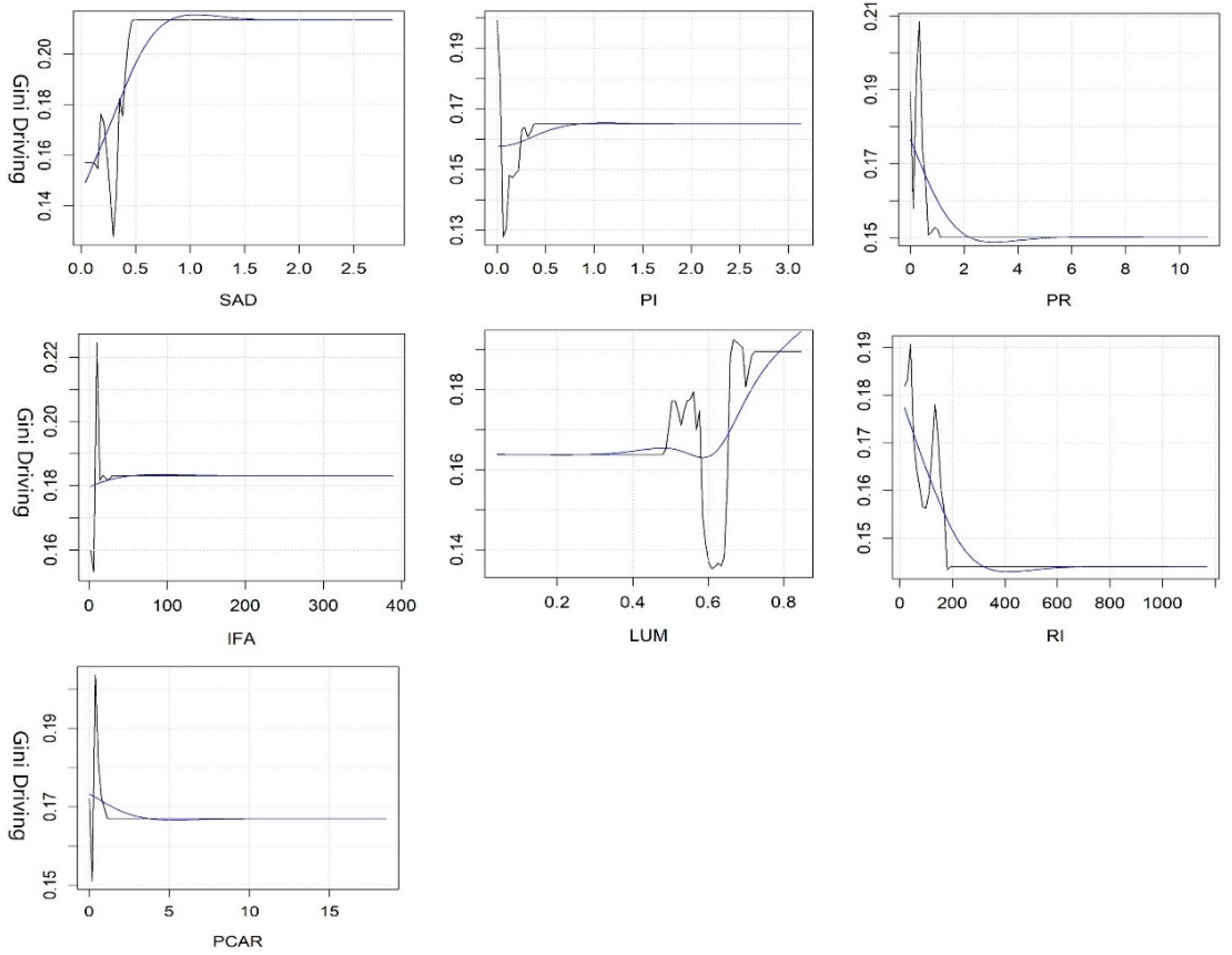
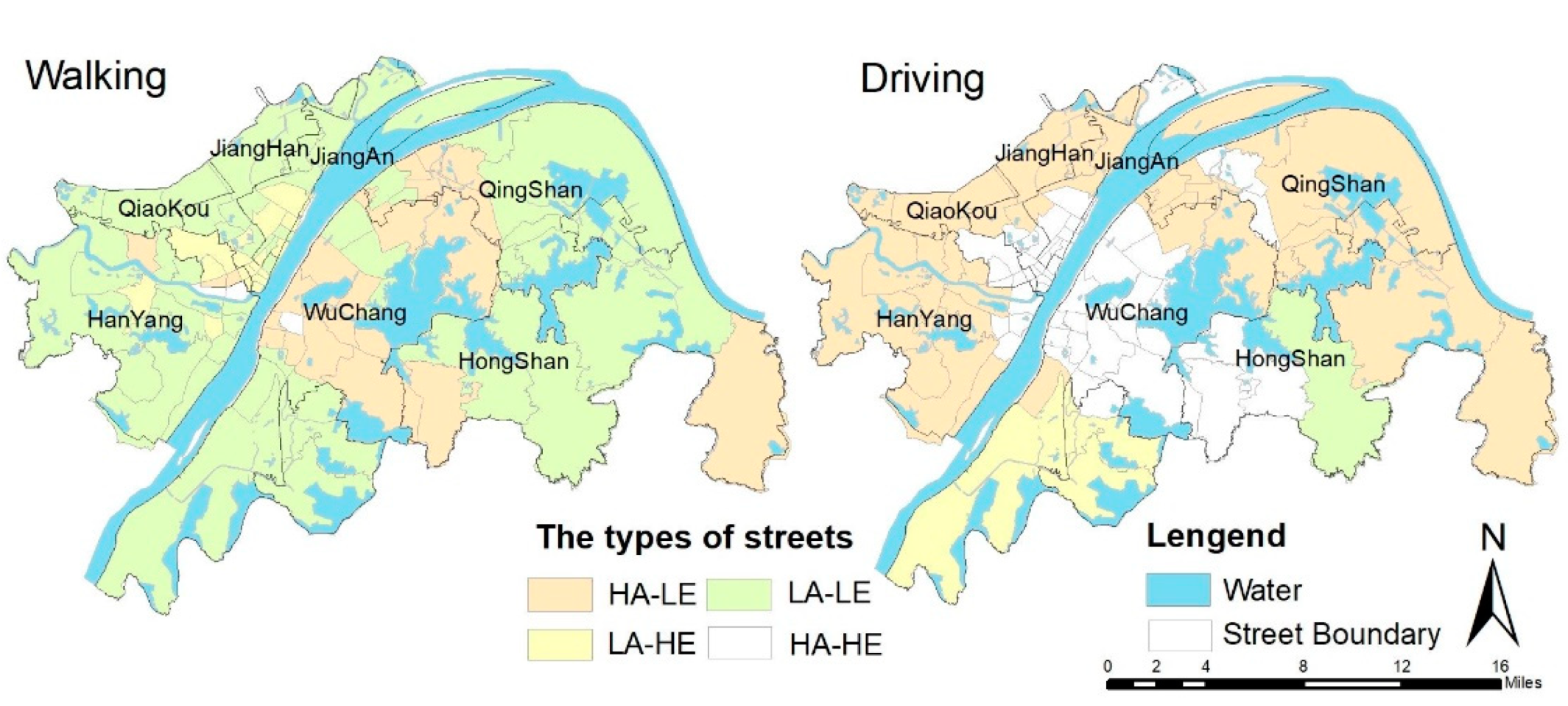
| Variables | Description | Mean (St. Dev) |
|---|---|---|
| Park characteristic factors | ||
| Per capita park area (PCAR) | Per capita park area of each street | 0.994 (2.596) |
| Park type number (PTN) | Park Type number of each street | 2 (1) |
| The shortest average distance to the nearest park (SAD) | The shortest average distance to nearest park in each street | 0.318 (0.365) |
| Built environment factors | ||
| Per capita normalized difference vegetation index (P-NDVI) | Per capita NDVI of each street | 0.091 (0.264) |
| Road network density (RD) | The ratio of total road length to street area | 0.005 (0.003) |
| Road intersections (RI) | Number of road junctions in each street | 116 (176) |
| Proportion of commercial land (PC) | The ratio of commercial land area to street area | 0.108 (0.182) |
| Proportion of residential land (PR) | The ratio of residential land area to street area | 0.398 (0.956) |
| Proportion of industrial land (PI) | The ratio of industrial land area to street area | 0.904 (1.744) |
| Degree of land-use mix (LUM) | Diversity of land-use types in each street | 0.587 (0.158) |
| Socioeconomic factors | ||
| Population density (PD) | The ratio of population to street area | 0.026 (0.024) |
| Gross domestic product (GDP) | Sum of the added value of various industries in each street | 11.578 (18.257) |
| Retail sales of consumer goods (RCG) | The sum of retail sales of consumer goods to urban and rural residents and social groups | 9.210 (14.263) |
| Budget revenue of public finance (PFBR) | Tax and non-tax revenue independently used by fiscal authorities | 0.790 (1.222) |
| Investment in fixed assets (IFA) | A comprehensive index reflecting the relationship between the scale, speed, and proportion of investment in fixed assets | 20.565 (45.772) |
| Districts Name | Grid Numbers | Gini—Walking | Gini—Driving |
|---|---|---|---|
| Jiangan | 792 | 0.71 | 0.38 |
| Jianghan | 609 | 0.82 | 0.44 |
| Qiaokou | 107 | 0.93 | 0.37 |
| Wuchang | 181 | 0.92 | 0.43 |
| Hongshan | 167 | 0.98 | 0.54 |
| Qingshan | 1244 | 0.93 | 0.38 |
| Hanyang | 568 | 0.88 | 0.29 |
| Overall | 3684 | 0.96 | 0.51 |
| Variables | OLS Model | GBDT Model (Rank/Relative Importance (%)) | |||||
|---|---|---|---|---|---|---|---|
| AI—Driving | Gini—Walking | Gini—Driving | AI—Walking | AI—Driving | Gini—Walking | Gini—Driving | |
| Park characteristic factors (the sum of all relative importance) | 1.92 | 5.42 | 14.45 | 20.24 | |||
| PCAR | 0.029 | −0.003 | −0.006 | (10) 1.88 | (9) 2.84 | (4) 6.21 | (7) 7.53 |
| PTN | −0.008 | 0.098 | 0.003 | (15) 0.04 | (14) 0.04 | (15) 0.54 | (15) 1.95 |
| SAD | −0.285 | 0.308 | 0.118 | (7) 4.18 | (12) 2.53 | (2) 7.70 | (1) 10.76 |
| Built environment factors (the sum of all relative importance) | 28.56 | 60 | 67.25 | 51.76 | |||
| P-NDVI | −0.432 | 0.062 | 0.233 | (6) 4.74 | (2) 23.13 | (8) 5.47 | (12) 4.75 |
| RD | 91.090 | −46.123 | −0.834 | (14) 0.45 | (5) 7.46 | (7) 5.57 | (10) 5.41 |
| RI | 0.000 | 0.003 | 0.000 | (11) 1.88 | (8) 2.90 | (6) 5.80 | (6) 7.96 |
| PC | 0.370 | −0.014 | −0.069 | (9) 2.32 | (4) 8.01 | (3) 6.68 | (11) 5.29 |
| PR | −0.069 | 0.002 | 0.004 | (12) 1.32 | (3) 12.14 | (1) 34.73 | (3) 9.81 |
| PI | 0.219 | 0.069 | −0.012 | (3) 14.43 | (11) 2.59 | (10) 4.21 | (2) 10.01 |
| LUM | −1.591 | 0.612 | 0.202 | (8) 3.42 | (7) 3.77 | (9) 4.79 | (5) 8.44 |
| Socioeconomic factors (the sum of all relative importance) | 65.34 | 34.56 | 18.28 | 28.08 | |||
| PD | 22.294 | −0.271 | −1.205 | (1) 20.86 | (1) 25.35 | (5) 6.08 | (13) 3.90 |
| GDP | −0.185 | −0.036 | 0.000 | (4) 13.75 | (13) 1.06 | (11) 3.96 | (8) 6.76 |
| RCG | 0.032 | 0.005 | 0.002 | (5) 12.87 | (6) 5.27 | (13) 3.32 | (9) 5.93 |
| PFBR | 2.195 | 0.458 | −0.071 | (13) 0.51 | (15) 0.20 | (14) 1.44 | (14) 3.03 |
| IFA | 0.008 | 0.002 | 0.000 | (2) 17.35 | (10) 2.68 | (12) 3.48 | (4) 8.46 |
| R2 | 0.26 | 0.39 | 0.30 | 0.32 | 0.42 | 0.57 | 0.92 |
Publisher’s Note: MDPI stays neutral with regard to jurisdictional claims in published maps and institutional affiliations. |
© 2022 by the authors. Licensee MDPI, Basel, Switzerland. This article is an open access article distributed under the terms and conditions of the Creative Commons Attribution (CC BY) license (https://creativecommons.org/licenses/by/4.0/).
Share and Cite
Du, S.; He, H.; Liu, Y.; Xing, L. Identifying Key Factors Associated with Green Justice in Accessibility: A Gradient Boosting Decision Tree Analysis. Int. J. Environ. Res. Public Health 2022, 19, 10357. https://doi.org/10.3390/ijerph191610357
Du S, He H, Liu Y, Xing L. Identifying Key Factors Associated with Green Justice in Accessibility: A Gradient Boosting Decision Tree Analysis. International Journal of Environmental Research and Public Health. 2022; 19(16):10357. https://doi.org/10.3390/ijerph191610357
Chicago/Turabian StyleDu, Sainan, Huagui He, Yanfang Liu, and Lijun Xing. 2022. "Identifying Key Factors Associated with Green Justice in Accessibility: A Gradient Boosting Decision Tree Analysis" International Journal of Environmental Research and Public Health 19, no. 16: 10357. https://doi.org/10.3390/ijerph191610357
APA StyleDu, S., He, H., Liu, Y., & Xing, L. (2022). Identifying Key Factors Associated with Green Justice in Accessibility: A Gradient Boosting Decision Tree Analysis. International Journal of Environmental Research and Public Health, 19(16), 10357. https://doi.org/10.3390/ijerph191610357






